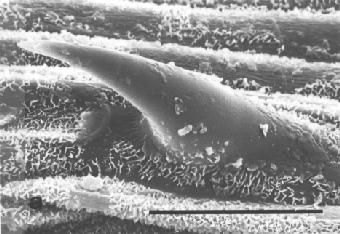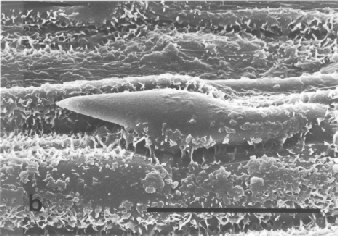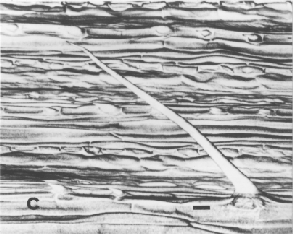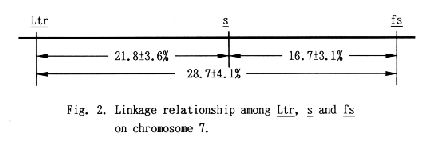

So far, hairy leaf sheath (Hs, Patterson and Shands, 1957), hairs on lemma nerves (Hn, Takahashi et al., 1957) and pubescent leaf blade (Pub, Wolfe and Franckowiak, 1991) have been reported as hairiness characters in barley. Here we will report the inheritance and linkage relationship of a new hairiness trait "large trichome".
Although the size of large trichome is about four times of the normal one (Fig. 1), the character cannot be recognized with the naked eye. But it is easily identified by the roughness of leaf touch. The large trichomes develop on both sides of the leaf blades, and the direction of trichomes are both acropetal and basipetal. It is clearly distinguished from extremely long trichome with Pub (Fig. 1).
About 2,300 varieties of our Barley Germplasm Center were screened by the leaf touch to find nine varieties with large trichome. They were all hulled type. Two of them were sixrowed local varieties from Pakistan, and others were two-rowed varieties from Europe and Japan.
Crosses of six large trichome varieties with a normal Japanese variety resulted in the large trichome type F1's, suggesting the dominant nature of the trait.
The large trichome line Hokuiku 17 was crossed with various linkage testers to study the mode of inheritance and the linkage relationship of the gene. In the F2 populations the large trichome was controlled by a monofactorial dominant gene and named Ltr (large trichome). It was independently inherited from following marker genes; br (brachytic) and gl5 (glossy leaf) on chromosome 1; li (liguleless) and v (six-rowed) on chromosome 2; uz (uzu or semibrachytic) on chromosome 3; K (hooded lemma) and gl3 (glossy seedling) on chromosome 4; trd (third outer glume) on chromosome 5; o (orange lemma) on chromosome 6. From the cross between Hokuiku 17 and OUL166, Ltr was found to be linked with s (short-haired rachilla) and fs (fragile stem) on chromosome 7. The arrangement of the genes is shown in Fig. 2.
Ltr may be a useful marker gene on the chromosome 7, and it is also an interesting gene to studv the morphogenesis of the trichome.



Although the allelism test is not completed, the very low frequency of the large trichome type (9/2,300) indicates that the variant is resulted from a recent mutation event, or the fitness of the variant is low in the natural and/or artificial selection. Significance of the large trichome on the adaptation and agricultural practice is a future subject to be investigated.


Patterson, F. L., and R. G. Shands. 1957. Independent inheritance of four characters in barley. Agron. J. 49:218-219.
Takahashi, R., J. Hayashi, and S. Yasuda. 1957. (Four genes in linkage, which are inherited independently of the markers in the known seven linkage groups in barley.) Nogaku kenkyu 45:1 - 10. (Japanese).
Wolfe, R. I., and J. D. Franckowiak. 1991. Multiple dominant and recessive marker stocks in spring barley. BGN 20:117-121.